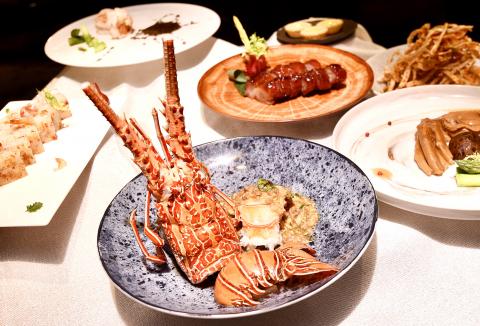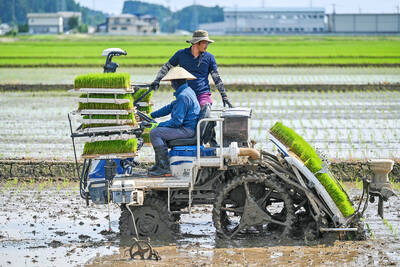A total of 24 restaurants won the prestigious Michelin stars in the Michelin Guide Taipei 2019, which was officially released on Wednesday. Cantonese restaurant Le Palais at the Palais de Chine Hotel was again the only restaurant bestowed three stars. Shoun RyuGin, the Guest House at the Sheraton Grand Taipei Hotel, RAW, Tairroir and Sushi Amamoto each clinched two stars.
Meanwhile, 18 were recognized with one star: Da-Wan, Danny’s Steakhouse, Golden Formosa, Ken An Ho, Kitcho, L’Atelier de Joel Robuchon, Longtail, Ming Fu, MUME, Sushi Nomura, Sushi Ryu, Three Coins, Tien Hsiang Lo, Ya Ge, Impromptu by Paul Lee, Logy, Mountain and Sea House and Tainan Tantsumien Seafood Restaurant.
Many of the Michelin-starred restaurants were winners in last year’s inaugural edition. Some operators said that their business has increased by 20 to 30 percent since they were awarded the stars, which have helped them attract foreign tourists in particular. However, several winning restaurants have shut up shop in the past year due to the high rents in Taipei.

Photo: Peter Lo, Liberty Times
照片︰自由時報記者羅沛德
(Eddy Chang, Taipei Times)
《米其林指南台北2019》於本週三正式公布,總共有二十四家餐廳榮獲著名的米其林之星。君品酒店的頤宮粵菜餐廳又再度成為唯一被授予三星的餐廳,祥雲龍吟、台北喜來登大飯店的請客樓、RAW、態芮、鮨天本,分別贏得二星的榮耀。
此外十八家餐廳今年受到一星的表揚:大腕、教父牛排、金蓬萊遵古台菜、謙安和、吉兆割烹壽司、侯布雄、Longtail、明福台菜海產、MUME、鮨野村、鮨隆、大三元、天香樓、雅閣、Impromptu by Paul Lee、Logy、山海樓台菜、華西街台南擔仔麵。
而不少摘星的名店亦是去年首次指南的贏家,有些經營者說自從他們摘星後,生意增加了兩到三成,特別是幫他們吸引了不少外國觀光客。但因台北市房租高漲,在過去一年已有數家曾上榜的店家結束營業。
(台北時報張聖恩〉

Rice is essential to Japanese culture, tradition and politics. People take pride in the oval-shaped sticky Japonica grain, which is still a staple even though total consumption has fallen over the decades. But since last summer, prices have soared as supplies have fallen short of demand. The government has long paid farmers to cut back on rice acreage, and change to other crops to keep rice prices relatively high. To cope with shortfalls this year, the government has released rice reserves. But the grain has been slow to reach supermarket shelves. Anger over that was part of the reason the Agriculture Minister

In Taiwan, 7-Eleven convenience stores can be found on almost every street corner. With over 84,600 stores across 20 countries, 7-Eleven has more locations than any other retail business on Earth. For millions of people, the chain is an important part of daily life, providing coffee, quick meals, and essential items for those __1__. The history of 7-Eleven began nearly 100 years ago in Dallas, Texas. In 1927, the Southland Ice Company began selling blocks of ice that were used to keep fridges cool. Shortly after opening, the company __2__ its offerings to include groceries like milk, eggs, and

Step into any corner of Turkiye, and you’ll likely encounter the iconic “Evil Eye,” known as “nazar boncu?u” in Turkish. This striking blue glass ornament is shaped like an eye with concentric circles of dark blue, white, and light blue. While its name in English suggests something threatening, it’s actually a charm designed to ward off misfortune. The origins of the nazar boncu?u can be traced back to ancient Mediterranean and Middle Eastern traditions. The word nazar comes from Arabic, meaning “gaze,” while boncu?u translates to “bead” in Turkish. Central to the nazar boncu?u’s mythology is the idea that

Continued from yesterday(延續自昨日) https://www.taipeitimes.com/News/lang In 1946, the company adopted the name 7-Eleven to reflect its newly extended __3__, from 7am to 11pm, a novel concept at the time. As a rapidly growing company, it began offering franchise opportunities in the 1960s. In 1974, the first 7-Eleven in Japan was opened by the supermarket company Ito-Yokado. The Japanese franchises were __4__ successful that by 1991, Ito-Yokado was able to acquire a 70 percent stake in Southland Corporation. Its investments eventually resulted in full ownership of 7-Eleven, which paved the way for the Japanese company to enter the international market. Since then, 7-Eleven